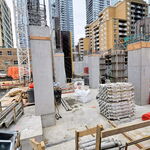AlvinofDiaspar
Moderator
I think the hospital row does not want their underground connections publicized maybe?
But I definitely agree, that the connections around Bloor should be included as part of the PATH network map.
Re: Hospital Row tunnels - they are not designed for used by the general public. The longest one from MSH to TGH across University Ave. is crudely finished and barely wide enough for two wheeled stretchers/beds to pass side by side (if that). Having said, I had brought up the idea of having a quasi-public PATH like system as part of a consolidated access/public realm plan for the district.
AoD




